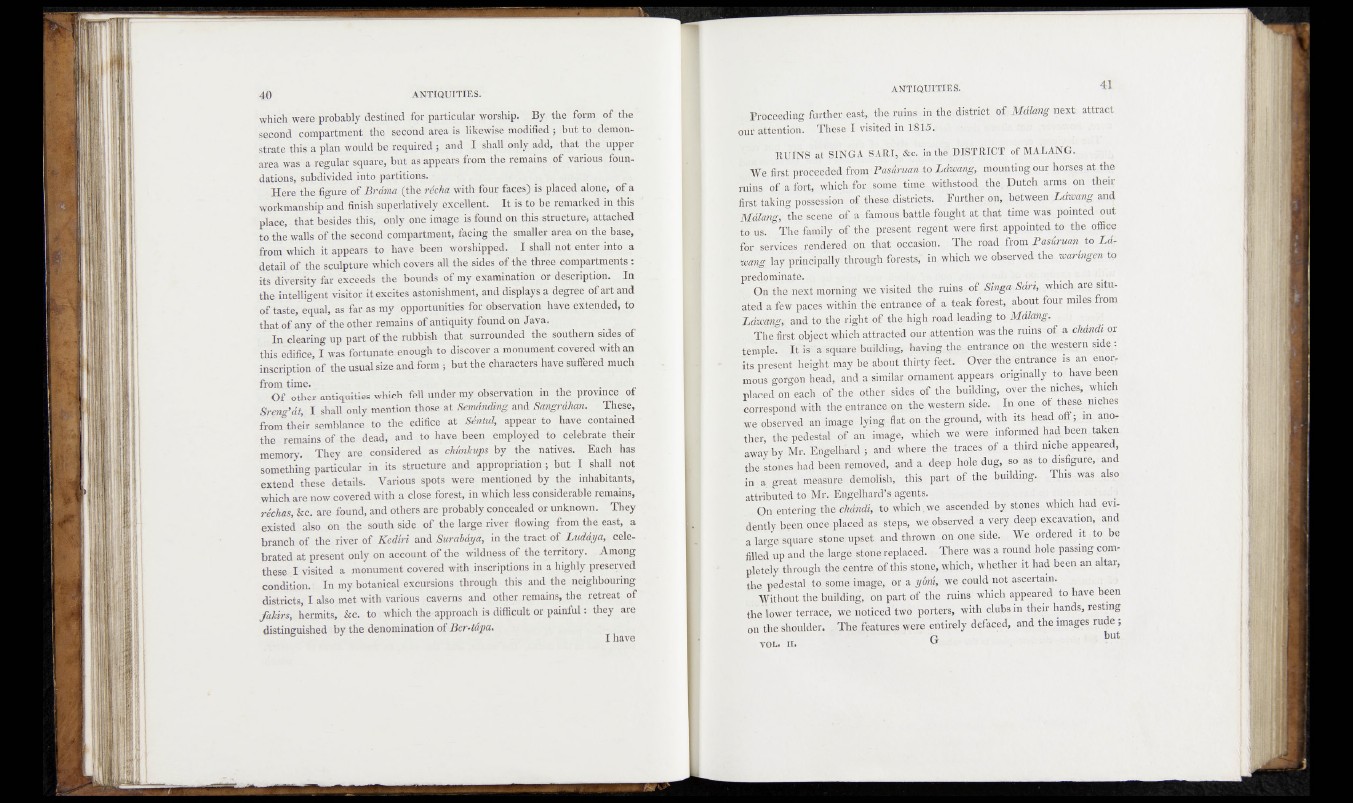
40 ANTIQUITIES.
which were probably destined for particular worship. By, the form of the '
second compartment tboe second area is likewise modified ; {but ^.demonstrate
this a plan would be required;; and I shall only add, that' the $pp.er
area was a regular square, hut as appears from the remains o f yapoify jf$u£-
dations, subdivided into partitions.
„ Here the figure of Brdma .(the recha with-four feces) is placed alope, of a ^
workmanship and finish superlatively excellent. It is tq be remarked in this '
place,- that besides this,' oplyfone image is found on this structure, attached ‘
to the.walls df the second'compartment, facing the smaller area on-t% base, ‘
from which it appears to have been worshipped;; I shad apt eptprtipto a
detaif.of the sculpture which covers'all the sides of the three'.compartments :
its diversity far exceeds the bounds of my examination" or'description. In
the, intelligent visitor, it excites astonishment, and displays, a, degrep of art and
of taste, equal, as far as my .opportunities for observatiqn have, extended, to
that of any of. the other remains of antiquity foundop. Java.
In clearing up part of the rubbish' -Aat- surrounded 'the southern.
thus edifice, I was fortunate enough to discover a monument covered wi^ny}
inscription of the usual size and form; but the.characters' have suffered much
from time., a i » . L
Of other antiquities which fell under my observation in the .province-of
Srgng’dt,' I shall only mention those at Semdnding. tmA'Sangrdhan. ' T^ese,
from -their semblance to the edifice at Sdntul, appear to have contained '
the. remains of-the dead, and to have been employed to .'gplebrate. tjieir
memory. They are considered as chunkups by the natives,Each has
something particular in its structure and appropriation ; but I shall not
extend these details. Various spots were. menticmed by the inhabitants,
which are now covered with a close.forest, in which less considerable remains,
rechas, &c. are found, and others are probably concealed or unknown. They
existed also on the south side of. the large river flowing from the east, a
branch of the river of Kediri and Surabdya, in the tract of Luddya,_f celebrated
at present only on account of the wildness of.the territory. Among
these I visited a monument covered with inscriptions in a highly preserved
condition.' In my botanical excursions through this and the neighbouring
districts, I also met with various caverns and. other remains, the. tetreat of
fakirs, hermits, &c. to which the approach is difficult or- painful: they are
distinguished by the denomination of -Ber-tcipa- • ■
I have
, Proceeding further» e^afe^e, ruin^Jfft.th^disiaOt o ^ d h n g next; attract
ourfattention. These T visited in.T815.«- ^
Rt|^fj0[t S Us[GAi(S
We, BO^tinapfiij.^o)r |^ ^ : .% ‘
.^ ta k in g ,Wd
mictygt famoi^jbattre^fqught atLthat .time \ya^«p.ted/put -
■ to&sL fa^iljoqf the,precepttregent yfeEef,f} r s ty ap p q ip^ ed o ffice
for,"services trend'^d^on that
H i n ,y^ich B I K U paringey to'
r&edoroip^te.(j< 7(i zr-Av tPulnr-i:o n: jo ‘!V . - J ll-ln
* O n lb i next morning ;y%yisitefl'thef ^ n sAo f^ ip g g ^ ^ » 'S ^ ig ^ e ^ ta-
ated a^fewf^es within'the entrance o f a teak forest, jibP%ti^^pfiles]frorn
Ldwayg* and tpjfherright;.of the;high rqadJeading.tq.Afd^ig, . t
Tb§ j jg f fibi jBt^bich attracted our^atfention was the ruins£q| a chandj,^
ntempleT^^Ittisfarsquare building, havio^th^e^Mqer’on^thr^qit^m s^ej;
"5 sB B B M B B be about H H H | B B ’entrance is an>eno&
l_mous gorggn head, !#p4\a-simikr.p^ have^fen
placed on each^&the. other si&es,of,,the*building^^'^nichesj«which
correspond; jviththg entramse.on yesferp^ide;,., s
we obsesved An image-iyingcftat, on,tte ground, with- K B B g H l
ther, the pedestal bfe'an image, whicb^we were ^nforta^d-h^been,tafep
away by-Mr. Engelhard and; wher^tb& ftrac.es;pf^;tbifd.niejiel0appq^ed,
the stones (had been remojyed, and a ^ l e p ^ l ^ # ^ 80 as
in a^reat measure] demolish, this,, PFb #]|het building, ^ ^ y a s alsp,
attributed tb Mr. Engelhard’s-agents.^ ;n B B iB H H H H | ei B B B B S B 1
, On entering,the chdndi, toyhich^we aScended by;% n e^whK%^adi f vi-
dently been pncejjilaeed^a| steps, W^pbseiijYedt'P,?itPi.#eP: gx.9ayati°nt apd
a large-square stone, upset .and thrown; on on^s id e^^e ordered;jt tpy be
fllled up and thftlarge .sfon^ep,laced. SuThere was a rqun4xhole.passing comr
pletely through-the centre of,this stone,,w^ich}' whethe.r-it .had been an altar,
the pedestal to,some image, ;or,a ybrfa,, we cpul^hot ascertain. .. , : ,
Without thljbuilding, on part of the ruins' which appeared to have been
the lower terrace, we noticed two porters, with clubs in their hands, resting
on the shoulder,. tfThn features yere-entirely defaced, and the images ru|e;
n . I | but,.
VOL. II.